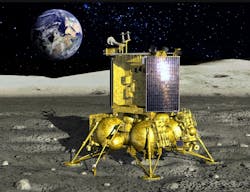Russia launches lunar lander in race to find water on moon
MOSCOW - Russia launched its first moon-landing spacecraft in 47 years on Friday in a bid to be the first nation to make a soft landing on the lunar south pole, a region believed to hold coveted pockets of water ice, Guy Faulconbridge and Joey Roulette report for Reuters. Continue reading original article.
The Military & Aerospace Electronics take:
14 August 2023 - The National Aeronautics and Space Administration (NASA) describes the Russian Luna 25 as " lander has a four-legged base containing the landing rockets and propellant tanks, an upper compartment holds the solar panels, communication equipment, on-board computers, and most of the science apparatus. Dry mass is about 800 kg, and it is expected to have roughly 950 kg of propellant at launch. The lander has a 1.6 meter-long Lunar Robotic Arm (LRA, or Lunar Manipulator Complex) to remove and collect the surface regolith to depths of 20 to 30 cm. The LRA is equipped with a scoop (175 cubic cm volume) and a sample acquisition tool, a 4.7 cm long tube with an internal diameter of 1.25 cm. The arm has four degrees of freedom / rotations: azimuthal, shoulder, elbow, and wrist/scoop. Total mass of the LRA is 5.5 kg, it uses 30 W nominal, and 50 W maximum power."
The agency continues, "There are eight science instruments. ADRON-LR is a gamma-ray and neutron spectrometer to study the surface regolith. ARIES-L detects charged particles and neutrals in the polar exosphere. LIS-TV-RPM, an infra-red spectrometer, measures surface water and OH and is mounted on the LRA. The LASMA-LR mass spectrometer will measure composition of regolith samples (1 - 2 cubic cm) from the LRA using laser ablation. The PML detector will study dust in the polar exosphere. STS-L is a panoramic and local imaging system. THERMO-L will study the regolith thermal properties, and the lander will also carry a laser retroreflector panel. Data transmission rates back to Earth are planned to be 4 Mbits/sec."
Related: NASA seeks industry proposals for next-gen Lunar Terrain Vehicle
Related: NASA seeks info from industry as it looks at lunar, Martian infrastructure and exploration
Related: Australian Space Agency selects Fugro-led AROSE consortium for lunar rover mission
Jamie Whitney, Senior Editor
Military + Aerospace Electronics
